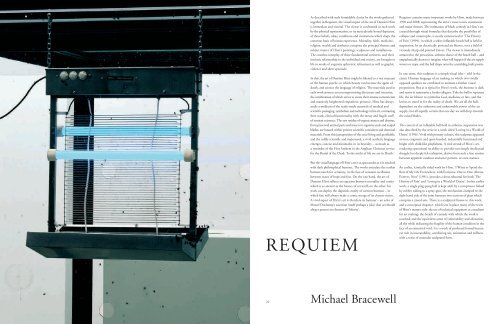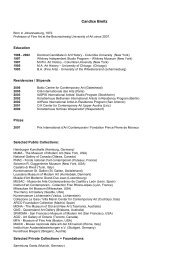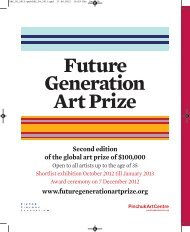Download pdf catalogue - PinchukArtCentre
Download pdf catalogue - PinchukArtCentre
Download pdf catalogue - PinchukArtCentre
You also want an ePaper? Increase the reach of your titles
YUMPU automatically turns print PDFs into web optimized ePapers that Google loves.
As described with such formidable clarity by the works gathered<br />
together in Requiem, the visual impact of the art of Damien Hirst<br />
is immediate and visceral. The viewer is confronted in each work<br />
by the physical representation, or its meticulously honed depiction,<br />
of those beliefs, ideas, conditions and institutions which shape the<br />
common basis of human experience. Mortality, faith, medicine,<br />
religion, wealth and aesthetics comprise the principal themes and<br />
subject matter of Hirst’s paintings, sculptures and installations.<br />
The ceaseless interplay of these fundamental concerns, and their<br />
intrinsic relationship to the individual and society, are brought to<br />
life in works of exquisite aphoristic refinement as well as graphic<br />
violence and sheer spectacle.<br />
In this, the art of Damien Hirst might be likened to a vast museum<br />
of the human psyche, in which beauty can become the agent of<br />
death, and science the language of religion. The materials used in<br />
each work possess an uncompromising directness and intensity,<br />
the combination of which serves to create their intense romanticism<br />
and massively heightened empathetic presence. Hirst has always<br />
made a medium of the ready-made materials of medical and<br />
scientific packaging, symbolism and technology in his art, contrasting<br />
their stark, clinical functionality with the messy and fragile stuff<br />
of sentient existence. The raw residue of organic matter and detritus,<br />
from preserved animal parts and insects to cigarette ends and scalpel<br />
blades, are housed within pristine scientific containers and chemical<br />
materials. From this juxtaposition of the once living and perishable,<br />
and the coldly scientific and impersonal, a vivid aesthetic language<br />
emerges, concise and minimalist in its brutality – as much as<br />
a reminder of the First Anthem in the Anglican Christian service<br />
for the Burial of the Dead: ‘In the midst of life we are in Death.’<br />
But the visual language of Hirst’s art is as spectacular as it is touched<br />
with dark philosophical humour. The works articulate the restless<br />
human search for certainty, in the face of constant oscillation<br />
between states of hope and fear. On the one hand, the art of<br />
Damien Hirst reflects an equation between mortality and vanity<br />
which is as ancient as the history of art itself; on the other, his<br />
work can deploy the slapstick cruelty of cartoon humour – in<br />
which fate will always make a comic stooge of its chosen victim.<br />
A vivid aspect of Hirst’s art is therefore its humour – an echo of<br />
Marcel Duchamp’s assertion (itself perhaps a joke) that art should<br />
always possess an element of ‘hilarity’.<br />
REQUIEM<br />
Requiem contains many important works by Hirst, made between<br />
1990 and 2008, representing the artist’s most iconic statements<br />
and major themes. The intimation of black comedy in Hirst’s art,<br />
created through visual formulae that describe the possibility of<br />
collapse and catastrophe, is neatly summarised in ‘The History<br />
of Pain’ (1999), in which a white inflatable beach ball is held in<br />
suspension, by an electrically powered air blower, over a field of<br />
viciously sharp and pointed knives. The viewer is immediately<br />
attracted to the precarious, airborne dance of the beach ball – and<br />
empathetically drawn to imagine what will happen if the air supply<br />
wavers or stops, and the ball drops onto the unyielding knife points.<br />
In one sense, this sculpture is a simple visual joke – told in the<br />
classic Hirstian language of art making, in which two vividly<br />
opposed qualities are combined to animate a further visual<br />
proposition. But as is typical in Hirst’s work, the humour is dark<br />
and seems to summarise a further allegory. Take the ball to represent<br />
life, the air blower to symbolise God, medicine or fate, and the<br />
knives to stand in for the reality of death. We are all the ball,<br />
dependent on the unknown and unknowable power of the air<br />
supply, but all equally certain that one day we will drop towards<br />
the raised blades.<br />
The conceit of an inflatable ball held in airborne suspension was<br />
also described by the artist in a work titled ‘Loving in a World of<br />
Desire’ (1996). Vivid with primary colours, this sculpture appeared<br />
at once enigmatic and open-handed, industrially functional and<br />
bright with child-like playfulness. A vital strand of Hirst’s art,<br />
rendering operational its ability to provoke not simply intellectual<br />
thought but deeply felt realisation, derives from such a fine tension<br />
between apparent candour and utter portent, or even menace.<br />
An earlier, iconically titled work by Hirst, ‘I Want to Spend the<br />
Rest of My Life Everywhere, with Everyone, One to One, Always,<br />
Forever, Now’ (1991), provides a dress rehearsal for both ‘The<br />
History of Pain’ and ‘Loving in a World of Desire’. In this earlier<br />
work, a single ping-pong ball is kept aloft by a compressor linked<br />
by rubber tubing to a spray-gun, the mechanism clamped to the<br />
right hand side of the joint between two sections of glass which<br />
comprise a raised axis. There is a sculptural finesse to this work,<br />
and a conceptual elegance, which sets in place many of the traits<br />
of Hirst’s mature style: the use of technical equipment as a medium<br />
for art making; the breath of comedy with which the work is<br />
touched; and the equivalent sense of vulnerability and alienation,<br />
all the while indicating the fragility of the human condition in the<br />
face of an existential void. It is a work of profound formal beauty,<br />
yet rich in inscrutability, combining wit, animation and stillness<br />
with a sense of muscular sculptural form.<br />
21<br />
Michael Bracewell






